Enigmatic escapes – Essaouira, Morocco
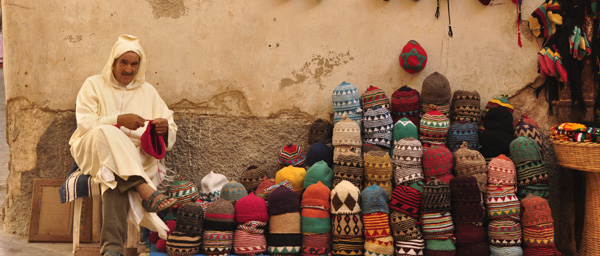
Juraba clad local selling hats in the back alleys of the beautiful seaside fort of Essaouira. Famous retreat of Jimi Hendrix and numerous other artisans.

Juraba clad local selling hats in the back alleys of the beautiful seaside fort of Essaouira. Famous retreat of Jimi Hendrix and numerous other artisans.
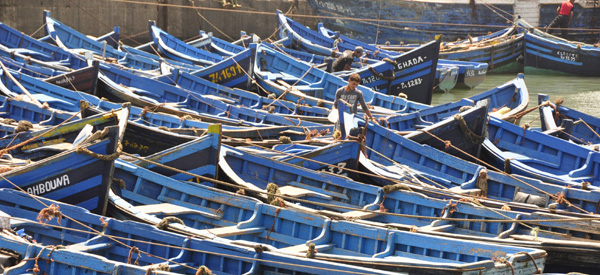
A crowd of blue fishing boats massing in the port of picturesque Essaouira. Everything in the ancient seaside fort is painted a combination of blue & white, making for a perfectly idyllic and relaxing encounter.
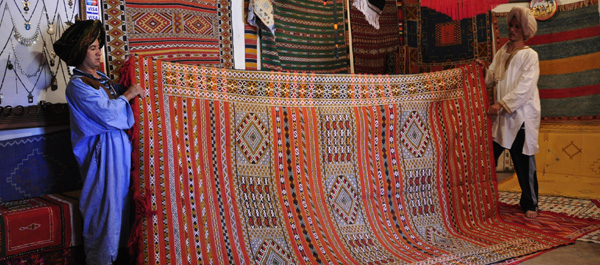
Some Saharan nomadic carpet salesmen, earnestly showcasing their wares in a desert Kasbah near the Atlas mountains.
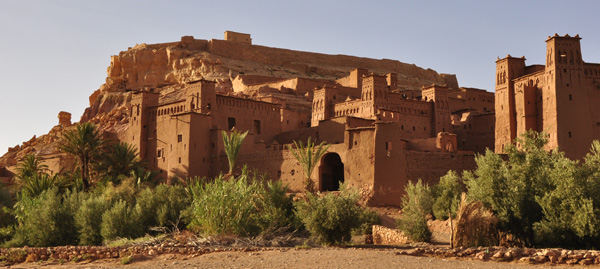
The famous mud kasbah of Ait Benhaddou used as the set for numerous movies such as Gladiator, Babel etc. One of hundreds that dot the oasis like valley floors across the Atlas mountains.
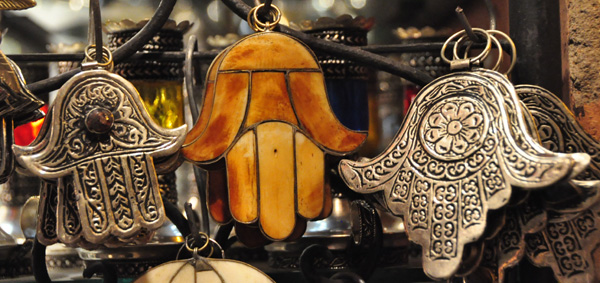
The Hamsa, a protection amulet used to ward off the evil eye (also known as Fatimah’s hand) – one of many tantalising symbols that define travel across Morocco the Middle East.
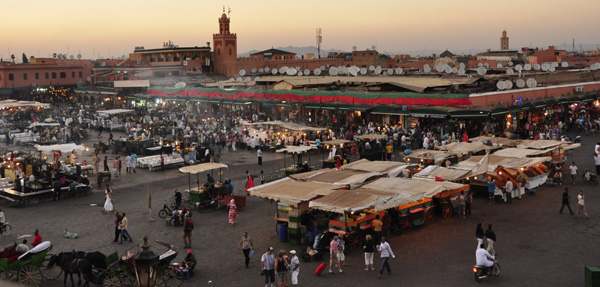
Eateries awaken as Ramaddan breaks over the famous Djemma El Fna square, centre of the ancient Medina and souqs of Marrakesh.
![Touchdown in Ramadan, Morocco First impressions of a place are always memorable, sometimes though when you are travelling you also have that moment, I’m sure you know what it […]](http://meltingplots.com/wp-content/uploads/2010/10/Ramadan.jpg)
First impressions of a place are always memorable, sometimes though when you are travelling you also have that moment, I’m sure you know what it feels like – nothing seems right all of a sudden, everything is foreign, threatening and heavy with intent and your instincts tell you that you are not universally aligned with this yet, that you have made a mistake, that you really should not be here. Arriving in Morocco during Ramadan was one of those for me.
Our plane got in from Paris late afternoon and my first Moroccan experience was getting into an argument with the taxi driver. Trying to bring down his rates to what I thought was an acceptable level, 12 months of travelling at least automatically trains you this way. After some heated discussion I was taken over to a faded official looking sign and shown the standard tariffs and made to realize I was undershooting the mark considerably, it was a 30km drive into town. I was gearing myself up a little too much for the infamous Moroccan rip-off I guess, but it set the scene appropriately enough. By the time we reached downtown Casablanca it was 6pm, the taxi driver had been driving way to fast, desperate to get us to our destination so that he could get home to his family to break his fast when the sunset. Can’t say I blame him really, if I hadn’t had anything to eat, drink or smoke all day I would be equally as daring I suspect. As he dropped us off though, he started in with that now familiar drama of pretending not to have any change, (even though I had seen him pull out the right note and hurriedly return it quickly to his pocket). What followed was a feeble show at an attempt to get change from a corner store and then the ‘I need to eat – its Ramadan’, just give it too me because you are a foreigner and must be rich, guilt routine. After our drama at the get-go this was a game I didn’t care to lose, me being a man of principles and all. So I started wandering to a couple of corner stores requesting change until eventually I just bought some water to get it all done. The driver by this time was yelling at me and playing furious. I finally got him his cash and he departed with a tire spin and a whole torrent of abuse in Arabic. Not an auspicious start really.
After that, we roamed a few blocks in downtown Casablanca looking for a hotel. Everything was closed, no shops were open anywhere, dust and rubbish flowed in the streets, young dodgy looking locals and rapid dogs cast nervy, threatening sidelong glances our way and all the hotel owners seemed disinterested to put it mildly. We eventually checked into a relatively clean looking cheapie and since things were now dark outside figured it was safe to go find something to eat. The earlier picture hadn’t changed though and if anything seemed worse, a few coffee shops were open with a scattering of men inside ominously smoking and drinking tea; more young, dangerous looking guys were about and it took us 30 or 40 minutes to find somewhere resembling a restaurant to eat at, there was not another foreigner in sight. As we sat down to order, I had that sinking feeling that I had made a big mistake. Morocco is a dodgy place at the best of times and travelling in Ramadan was obviously not going to work. Nothing of the vibrant, exciting colours and highs of the Morocco experience was going to be accessible. The place was going to be a grumpy, dangerous mortuary of entertainment. The last place in the world you would want to meet your parents for a week of shared travel.
Mom and dad had happened to be in Europe for a few months and since we were both in the same continent and hadn’t seen each other for a few years now, (long before we stated travelling), we had worked out a way to spend a week travelling together. I had sent them some options of places to go, but been pleasantly surprised and excited when they choose Morocco, by far the edgiest of the bunch. Mum, had been a little reticent later on once she had worked out Ramadan was on, but I had confidently reassured her that it would be great – it was the one side of the Muslim world we had yet to really experience in our travels. Now however that all seemed to be a remote pipe dream and extremely ambitious thinking. We were the seasoned travelers in charge of navigation, entertainment, planning, security and the rest. I couldn’t wait to see them, but was anxious to ensure they had a great time and experience and everything went smoothly.
Dinner was naturally a pretty sombre affair as I contemplated all this, an average meal not really helping to boost expectations either. As we walked outside though, (by this time about 9pm or so) the place was dramatically transformed. Suddenly the streets were heaving with people, unsavoury characters magically turned into extended families; cars and motorbikes woven into an intoxicating union of total congestion, while lights of all colours lit up the city in every direction. Stores were open everywhere and every sidewalk cluttered with spot market sellers, even the street cleaners were in operation cleaning up the days mess. The large centre square and fort walls of the old medina, previously abandoned now was a throng of markets and customers, touting all manner of touristy wares, vegetables and mobile phones. But it was the sound itself that left the biggest impression. Noticeably absent before, the place hummed with an energy and positivity that was both infectious and celebratory.
As we wandered the streets catching the mood, all the previous anxiety and tension eased away. The party seemed to continue all night and by morning I couldn’t wait for mom and dad to get here – it was different sure and was going to have it moments, but still going to be a lot of fun! We were just going to have to align ourselves a little differently with this strange new schedule and outlook, but that is what real experiences require anyway!
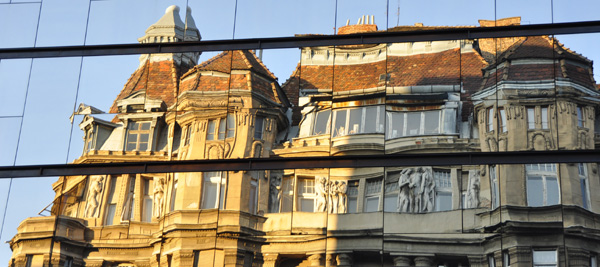
New meets old. A reflected image showcases one of the many architectural marvels hidden in the back streets of Berlin.
![On Buying Persian Carpets When we first started our trip, I had a little mental list (and budget set aside) for a few things I intended to pick up […]](http://meltingplots.com/wp-content/uploads/2010/07/Top2.jpg)
When we first started our trip, I had a little mental list (and budget set aside) for a few things I intended to pick up along the way. It was only a small list, I am not really given to souvenir shopping and this trip was quite importantly a chance to de-couple a bit from the material world. But I did like the idea of investing in a few quality pieces, unique embodiments of cultural experiences if you will, where the shopping would be as much part of the travel experience. To date I have only crossed a single item off this list, a small Tibetan Mandala (Thanka) from Nepal, I had also planned to buy a drum in Africa, but nothing really grabbed me there unfortunately and of course I felt compelled to pick up a carpet in Iran. Given Persian carpets are universally considered to be the best in the world, I did not want to pass up the opportunity when making all that effort to actually travel though Iran, it just seemed the logical thing to do.
Now, I know nothing about carpets really and had done no real research. Up against sellers with thousands of years of history, expertise and skill behind them, this was not a particularly thrilling prospect. Fortunately though, I had a partner in crime. Victor, a great mate from Tokyo had dropped by to join us for the Iranian leg of our adventure and was able to bring a sprinkling of knowledge, some basic background and most importantly some fresh enthusiasm to the quest. Keen as we were though, we still had no reference points in terms of prices, style preferences or quality, so when we spied an expensive looking Iranian carpet trader in a mall in Dubai, we ducked in for a bit of a sighter and practice run.
Carpet shops all tend to operate on a fairly basic formula. You walk into a shop with something interesting in the window or on the walls and starting looking around rather intelligently. The seller will then get excited, offer you a seat and most likely some tea and then start digging into his many piles of carpets. As he opens specific pieces up, he will hold them out and displaying them on the floor, stacked one on top of another into a large pile. Initially he goes through a wide sample of his inventory and as you make a show of appraising each piece, he tries to get a feel for what you are after so he can narrow down the style of carpets you might be in most interested in. When you have both worn out the options, he then goes back through the large pile on the floor one by one discarding any you don’t like. The final pieces are then isolated for your consideration and initial prices are given and more detail provided on the respective carpets background, key features. If something does take your fancy, then the negotiation process begins.
What you are interested in is the tricky bit. Carpets tend to come in 3 sizes big, medium and prayer mats (small) and there are thousands of different designs. A few decades ago there were as many as 7 million people making carpets in Iran and carpet shops are just about everywhere, dominating large sections of every bazaar. These days we heard that the number of people has declined to under 1.5 million, but its’ still a lot of people and given that some of the better carpets can take many months to a year to create, its a huge income provider.
Carpets are produced throughout Iran as well as the neighbouring regions of Azabaijan, Afghanistan, Turkey and Turkmenstan. Each area tends to specialize in a different style and carpet shops tend to accumulate their own network of providers or producers within a certain style range (or for those that do target foreigners accumulate a range of carpets that suite the Western taste). Esfahan is probably the most famous region, specializing in pure silk carpet designs of the highest quality with spectacular, complex floral arrangements similar to the designs of the Iranian mosques. But there are many other variants regionally which work to their own traditional patterns. And then there are the nomadic tribes, which produce carpets in their own distinct style based on the things they see around them. Often they can produce totally unique pieces inspired by every day life, with little pre-planning, they are usually slightly flawed but entirely original.
Judging a carpet is a complicated process – carpets tend to be classified (and priced) based firstly on whether they are made from Pure Silk, Pure Wool, Silk / Wool, Wool & Cotton or numerous other subtle variants (ie. camel wool or lambs wool), the gist being that the more silk used, the higher the price. Then there is the quality of the knots; carpets can be single or double knotted and are generally measured on the number of knots to an inch. The more knots the higher the quality which can be easily seen by turning a carpet over, the higher the quality of a carpet the more clear the design on the back of the carpet will appear to be. Age plays a part as well, older carpets tend to be a lot softer and are valued more highly. Starting to get the idea?
As we sat in our Iranian shop in Dubai feigning genuine purchase intent, I started to comprehend this rich and complex world as the carpets mounted on the floor in front of us. The incredible detail and quality of the Esfahan carpets was captivating, but the pre-dominate bright turquoise and white colour schemes just seemed to clash with everything I could conceive and I really wasn’t looking to spend thousands. The nomadic carpets however were much more interesting, deep / rich tones of red, the elegant designs of Turkmen & Belucci seemed to resonate well, more especially with Victor and the price tags around a thousand dollars or so seemed somewhat in reach. We had some benchmarks, some style ideas (and some budgets), promising we would think about we managed to escape the store. We were ready for Iran.
After checking out a carpet shop very briefly in Shiraz, we made our way to Yazd in the dry desert centre of Iran. As we were exploring the ancient mud alleys of the city, we stumbled across a small carpet shop with several large backrooms stacked full of what looked to be very interesting designs. Some quick investigations with the manager revealed that the shop specialized in Zorastrian carpets made largely by and for the Zorastrian community and that the carpets had largely all been pre-owned. A pretty interesting angle really, especially as we both had some fascination with the Zorastrian religion and rituals, so Victor and I settled into see what he had. Zorastrian carpets are quite unique in that they feature designs of fire temples, lotuses and many other practical features of daily life that make for especially good ‘carpet sales’ storytelling, it didn’t take either of us long to find something we liked and after going through the motions, had reduced our piles to a few specific final selections and were ready to negotiate. In the end I walked away with a small, 20 year old Zorastrian designed carpet for around $265, he had started at around $300 or so I think, but really had refused to negotiate – it was all price fixed by the community or so he said. I still thought it great value relative to what we had seen in Dubai though and our later forays revealed this to be the casse. Victor nabbed a very nice, medium sized Turkmen as well for about $450.
Our first big carpet trial and we had bitten the bullet already, which really took the pressure off. We were both happy and with our carpets wrapped up in newspaper and compressed into a small package, we continued onto Esfahan, famed for its bazaar and carpets alike. While Victor already had a big piece, I was still a little looking for one, so the focus was one me to find something I liked. We tried perhaps 4 or 5 tourist friendly stores specializing in nomadic carpets and after sitting down to various welcomes and tea, had hundreds of carpets thrown at us. Steering clear of the expensive Esfahani carpets, the initial ‘wow’ of it all was starting to wear off and while we came close a couple of times nothing was really grabbing me. Megumi meanwhile had started to go carpet blind and could no longer differentiate between them. So we decided to wait and see what the bazaars in Tehran held.
The Tehran bazaar turned out to be a massive labyrinth, largely domestic focused and very difficult to navigate. Carpet touts hang out at the entrances though waiting for tourists like us to rock up and guide them to key market sights and ultimately see their shops. We were found by a couple of such guys in our forays and led through the rabbit warren into huge carpet warehouses, replete with little backrooms on the upper stories for intimate display. All were incredibly friendly, spoke english and tended to specialize again in the nomadic pieces we were more inclined towards. A couple of times we found ones we liked, the price & range definitely better here than Esfahan, but we had a few days to explore, so we kept the pieces on hold and gave ourselves the chance to keep looking. Eventually as it always happens, we were wandering down a small alley, with carpet stores and squares spiralling off to all sides when a young guy speaking good English asked us if we wanted to see his shop. I am in Lonely Planet he said and shouted his name which I actually recognized from the bible. It was a good omen, so we followed him to his little room, braving the lack of air conditioning to check out his range. Jackpot! Hosseiny as it turns out travels a lot across both Iran and neighbouring lands buying interesting carpets from all around, but rather than focus on one style, he had an amazingly diverse range of quality pieces on offer, exactly what we had been looking for.
After pouring through the wide array of options, we found several pieces we both liked and went through the difficult task of paring it down to a final selection. After some constructive prompting from the support team, I dived in with a magnificent and totally unique masterpiece from a nomadic master near Sharvin in North Eastern Iran, while Victor picked up an excellent quality prayer mat. As luck would have it Hosseiny was also looking to just clear out his inventory so was willing to cut us very good deals just to move his merchandise. (at least that was his rather genuine story) My carpet cost about $600 in the end, he claimed he would normally expect to get at least double that which made me feel good.
Task and mission over, satisfied buyers both – Victor generously smuggled the pieces back to Japan for me, so I will have to wait another year or so to see them again. It will be a much anticipated reunion. Leaving Iran though, I was also filled of dreams of all the other pieces I would have loved to have bought and likely would have done had I even the remotest possibility of more floor space somewhere down the track. The colours, designs and weaves are all entrancing, but it is the intricate background stories and unique lifestyles wrought in thread that each piece immortalizes, that really draw you in. And in all, I found the experience thoroughly rewarding. The Iranian sales process was not the bullying, intimidation that I had imagined at all, but a largely pleasant, considered interaction and so it always should be I think – culture is being traded here.
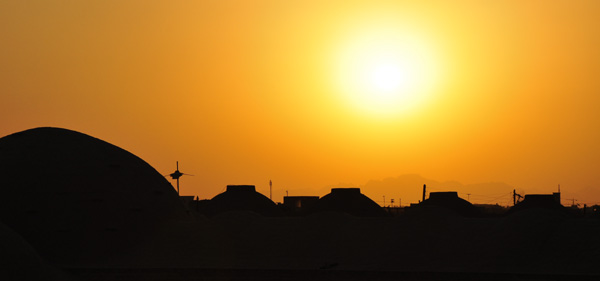
I have tried (rather ambitiously) to outline the overall experience of the Middle East in a single post here. I have done so, in part laziness perhaps, but more to try and create a sense of continuity or flow to the whole adventure, which is certainly how it felt for us. Where possible of course I will break out the key highlights into separate posts with more detail, so do bear with me!
After Africa, the Middle East was intoxicating, from the wilds of nature to the heights of ancient civilizations, the contrast couldn’t have been more stark or indeed welcome. It was ridiculously hot though, as an Australian I should know better than planning to wander around a place in 40 to 50 degree heat. In truth, I had started with a cunning workaround for the Middle East – spring, but an extra week here & there, another month or so in India and suddenly we were more than 2 months behind schedule and waddyano arriving slap, bang in the middle of summer. ‘Off season’, as its called here, basically because everyone else knows its’ ridiculously hot and stay away, did certainly make things a bit cheaper though and for the most part less crowded, so there were some perks to go with the sweat, sand & lethargy.
We were gearing ourselves for our arrival in Egypt, every traveller we met ‘coming the other way’ so to speak, warned us of the touts, ceaseless harassment, scams and hassles. Almost typically though now, we failed to encounter any of it – perhaps the African and Indian legs of our adventures had upped our immune system and tout tolerance to some ultra, advanced level so that everything appeared weirdly normal, or more simply that we were so grateful to be back in the zone of ‘civilization’ we barely noticed; either way it was an altogether pleasant letdown. Cairo turned out to be fascinating in its way – aging European in its downtown construction along the banks of the Nile, peppered with gardens, parks and nice hotels. By day, it was baking hot, dusty, noisy, chaotic traffic and seemingly empty of pedestrians, but truly came alive after sunset. As dusk sets in, the downtown streets pulse with a festival like atmosphere; Egyptians roam the sidewalks in their thousands perusing the endless window displays of plastic manikins advertising chadors, head scarfs, kids clothing, jeans and lingerie. While either side of the Nile, families, courting couples and groups of teens meander arm in arm soaking up the evening breeze and posing for photo’s. Everywhere side alleys teem with street eateries, tables, chairs, tea, backgammon and waterpipes.
Everything is open til at least 1am here, with young kids happily playing in the streets alongside the adults right up until the shops close. We spent several days simply walking around, soaking this up, so liberating after the confines of Africa. In the cities of Africa, darkness quickly takes on the feel of a demilitarized zone, even by day most streets are off limits and teeming with the threat of violence. Here we felt immediately safe, barely hassled except by the odd friendly greeting, the darkest alleys held no real threat. For me this is an essential component of travel, the ability to explore on foot, meet people and understand a place at street level, take that away and your experience of a place becomes fleeting, sterile, packaged even. Equally, there was an immense satisfaction in these new Muslim environments from the ability to just randomly slump into a sidewalk chair after a day of wandering about and order up ‘2 hookers with some coke’ and not even warrant a second glance from the young, eager staff. Somehow it just doesn’t seem to get old!
Underlying all of this of course was a new Islamic presence – everywhere women are covered head to toe, rarely do you see a woman’s hair in Egypt (except for the tourists at least). At minimum there is a scarf covering the head, with a white or black hair net underneath, certainly no arms or legs on display and at maximum a full black chador with only two slits for eyes and gloves. It certainly set the benchmark for the Middle Eastern experience; we found few other places as conservative as this. Mosques dot the skylines in all directions, with the grandest in old Cairo around the great souq / market. Although I have somehow evolved the ability to sleep in heavily over the years (now suddenly useful), Megumi awakes with the first call to prayer at 5am. And the subsequent day is peppered with the resounding repeats through the ever omnipresent loudspeakers for the morning, lunch and evening renditions. Accordingly people stop, close their shops and disappear in their respective directions for their prayer efforts. Green carpets suddenly fill the alleys and barefooted men, ablutionblocks mysteriously appear, previously unnoticed or dismissed as fountains as barefooted men go about their cleansing. At first this is disorientating – nothing seems open when you need it. But after a few days, you adapt to the rhythm and adjust to the routine that Muslim life necessitates.
Then amongst all this of course came the World Cup, the Egyptians (and the Middle East) is especially nuts about football, as just about everywhere is of course (outside India, the States & Australia anyway). Suddenly the entire days schedule seemed to fill up. After lunchtime prayers comes the first game at 2.30pm, followed by evening prayers and a second game at 5.00pm, before the final game of the day post evening prayers around 9.30pm. As a result all functional accomplishment seemed to rightly disappear with the heat, most particularly in the evening, as the streets filled with chairs and sheeshahs, all universally pointed in the direction of a TV. We were quite happy just to be carried along with it.
After the essential pharaonic explorations in Cairo and up the Nile to Aswan & Luxor, we journeyed by bus from Cairo down to the Sinai region and ultimately Dahab. A journey that crossed the Suez canal (an anti-climax) and along the arid shores of the Gulfs of Suez and Aqaba; then upon entering Sinai proceeded to be bogged down with innumerable security stops and checks. I seem to remember at least a dozen occasions that a young, smartly dressed Egyptian guy packing a piece, got on the bus and worked through each passengers’ passport or ID. On other occasions a road hump and street block worked the bus into a controlled traffic channel so that papers & vehicles could be expected. Terrorist bombings targeting tourists in this region (the most recent a couple of years back) have ensured such a close lock down, but it was still quite unexpected. Two young Egyptian guys in the seat in front of me actually got pulled off the bus – their national ID cards casting enough doubt around for some further questioning. It was also the first time in our travels that I have seen real military presence & weapons build up. In parts of Asia, India and Africa you almost get used to men standing around with machine guns on every corner. But several times on the side of the road we passed tank & armoured car divisions, the largest some 30 odd tanks neatly lined up ready for deployment. Somewhat guiltily, it excites and tickles the adrenaline all this stuff – too many war comics, computer games and action movies as a kid I guess.
Dahab is a curious place, once a tiny Bedouin camp in the desert it has evolved from hippy haunt to tourist mecca attracting all range of folk and budget travellers. Restaurants, hostels, pensions and trinkets peddlers line a thin strip of shallow coral, where the ocean drops off into a deep trench. It’s a pleasant enough place to relax, though if you don’t fancy camel rides in the desert, apart from climbing Mt Sinai and visiting Katherine’s Monastery (ie the site of Moses’ burning bush) or diving there was little else to do. (which is probably the point actually). We had heard that the Red Sea is some of the best diving around, but while it was enjoyable it didnt match the splendour, colour and diversity of Australia or Thailand, though perhaps I have been a bit spoilt here. In all I found Dahab, a little too touristy, it felt like it was trying too hard to be a ‘Thailand clone’, albeit short on trees and good food. Mind you, we have left the whole ‘holiday mode’ a long way behind us now, so perhaps we were just struggling to relate to the myriad of Russians, Brits and Europeans on their 2 week sabbaticals.
From Egypt, we crossed the Red Sea by fast ferry to Aqaba in Jordan – the Ferry was fast in operation only and we ultimately boarded some 5 hours late. Although while waiting in the large departure shed, we did manage to befriend an Irish, Polish and Chinese crew, bonding during the tedium of our shared adversity and who generously gave us a ride to Petra later on. Crossing the border by boat was not that interesting; visas and stamps were all collected on board the funky, cruise ship that also featured a fascinating assortment of Duty Free shopping obviously not targeted at the traveller market that made up the ships current consignment. (ie pots, pans, stereos, televisions, irons, washing machines).
Petra was amazing and worth another post in itself. Like the pyramids it was one of our key pilgrimage goals for the Middle East and everything we expected really. The entry to the secret valley through the 3 km winding carved rock channel to first view the great treasury building is exceptionally memorable. We ended up spending 3 days there exploring the ruins til late in the evening, meeting Bedouin lads and other fellow travellers. Without a doubt the highlight was an hour’s climb up the mountain past the main sights to the Monastery for a sunset. Here a friendly collective of Bedouin ran café’s overlooking spectacular viewpoints and sat around playing beautiful music on flutes and lyre and escorting us up secret paths to the Monastery roof. It was magical in every respect and quite ingratiating. We found the Jordanians – Bedouins and Palestinians to be genuinely warm, welcoming, liberal and relaxed, noticeably different from the Egyptians. We then followed that up with an overnight stay in Wadi Rum a 1 hour share taxi away, which is how Jordan seems to operate transport wise, soaking up the sublime landscape and some Bedouin hospitality with a tented camp in the desert. An experience shared with another Irishman we had befriended atop a rock at the Monastery and an Indian woman on leave, while her husband sat for a Doctor’s exam. As fascinating as DH Lawrence’s playground, the desert Bedouin and the landscape was, one day was enough in the heat and we headed onward to Amman, an entirely modern city, where we spent a night, doing little more than watch football with some locals before heading onto Syria and Damascus.
Damascus was one of the real highlights of our trip so far. After securing our Visa’s (Syrian was one of our most interesting experiences yet), we arrived mid afternoon and checked into the Al Rabie hotel, a beautifully restored old Damascan house with a large shared, open courtyard and pleasant rooms, then set about exploring the old town. Damascus lays claim to being the oldest continuously habited city (though it seems every country has one claim to this mantle in the Middle East) and the place teems with a labyrinth of landmarks, historical sights, pilgrims, shops and culture. Old Damascus is a curious mix of Sunni & Shia Muslim pilgrims, Christians and tourists; it shares space with ancient roman ruins, mosques with sacred Muslim sights (including the Prophet ‘John the Baptists’ head & Immam Reza’s tomb), along with Christian landmarks (ie the location of Paul’s conversion and escape); there are also palaces, forts and beautiful old houses here, all adorned with their quirky variations on the ‘copper hand’ doorknockers. But it is the markets and café’s that are most bewitch – The bazaar an intricate network of beautiful wooden doors, paved alleys all heaving with Damascus’ famed inlaid handicrafts, metalwork and fabrics, complimented nicely by the plethora of interesting café’s and restaurants scattered throughout and seemingly hiding around every corner or alleyway. It’s simply an amazing place to explore; the food fantastic & the Syrian people incredibly friendly and welcoming; a long way from the terrorist sponsoring underground of popular fiction. Damascus also coincided with the chance to reconnect with Lindz & Catie – fellow trekkers we had met in Nepal. They had come down via Iran / Iraq and Turkey, so we had plenty of catching up to do and information to trade for which we managed to raid a bar in the Christian quarter to happily facilitate!
Dragging ourselves away from Damascus we headed out along the road to Baghdad for Palmyra, and its stunning ancient Roman ruins close to the Iraqi border. Amazingly we had the whole place to ourselves (actually not really so surprising in the 50 degree heat I guess) and little competition for food or hotels. I also ended up watching a world cup quarter final with 50 other local Syrian men at the only place showing the game in town. Heading back inland, we passed a jet fighter base; each plane spectacularly silhouetted under its own bomb proof hanger roof, the surrounding network of hills was peppered with a beehive of deep bunkers, missile defense systems and sophisticated radar gear, as a spectacle it was almost more exciting than the ruins.
Leaving the desert behind, we based ourselves at a small town called Hama, famous for its network of large wooden windmills (there are almost 30 of them) called Noria’s that line the river and once used to channel water for the town. Some of the windmills are up to 1,500 years and as these babies turn with the water, they make a deep, eerie double base-like melody. Alongside the river, the entire town seems to reverberate with its melancholic rhythms. “When they stop”, a local told me,“ no-one can sleep here, it’s as though its’ the towns heartbeat”. In Hama, we connected with an English couple and an American woman (one of the few with a Syrian Visa) to explore the captivating nearby castle fort of Crac De Chaveliers as a day tour (booked through the hostel) and on a subsequent day, the Dead Cities, a tiny sample of some of the 700 stone village skeletons that litter the region, all strangely abandoned some thousand years before. We then spent a day getting lost in the souqs of Aleppo, the largest bazaar in the world and while not quite on a par with those of Damascus, we did take the chance to stock up on some of Aleppo’s famed olive soap before dashing across the border to Turkey.
After a brief, enforced schedule stop in the pretty border town of Antakya, we made our way to the stunning Cappadocia region in central Turkey. Arriving in Turkey was for us a ‘return to the first world’ after a 4 month Hiatus, the first time since South Africa probably that we were in a country that bare skin & uncovered heads abounded, shopping brands were familiar and many other creature comforts long forgotten, slowly could rear their heads to grateful recognition. Cappadocia and specifically Goreme, where we were based, was magical. The sculpted, hollow basalt towers, valleys and underground cities that define it, easily occupied several days of relaxed, but intrepid adventuring. Continuing onto Istanbul, we bypassed the rest of Turkey for the moment (it is more European these days anyway), rushing to connect with a flight to Dubai (via Kuwait) in order to meet up with Victor & Yuko (friends from Japan) ahead of exploring Iran.
Dubai was fascinating in itself. After exploring the ancient Middle East, seeing the regions most ambitious variant was a great counterbalance and poignant moment of pause to add to our experiences. Almost a more conservative local Muslim society than any other we have been to, the scale, architecture, ambition and almost insanity (rapidly being proved by its bankcrupcy) of the Emirates is something to behold. Not that there is a lot to do here; we explored endless air conditioned malls, climbed the worlds tallest building and found our way to Atlantis, a Disney style water park located at the very palm fronded-end of the man made miracle that is the Palm shaped Island resort (1 of 3). Dubai is a place, desperately trying to be relevant. Enshrined in its innumerable, albeit largely empty office towers there is an audacious lure to the world’s elite companies trying to plug an economic hole. While the malls, hotels and amusements serve to placate, tempt and distract the wealthy local population and tourists alike. Wajid and his wife, friends of Victor played fantastic hosts to us during our stay here and while there is no escaping the resultant hole in the wallet that Dubai aims to provide, it did prove a fantastic base to reconnect with old friends and witness an ‘other side’ that we had necessarily been avoiding in our budget driven country selection criteria’s to date.
Jumping a plane to Shiraz (via Bahrain) with Victor and Yuko, we then set about exploring Iran. As a group of 4 people, we were almost our own tour group and while it took a little while to align pace and style, it came as a welcome change to our usual, isolated random adventuring, not least because I had a carpet buying buddy! Iran itself defies all those preconceived stereotypes and notions, unwittingly forced on us by a relentless western media fuelled (literally) with ulterior motives. In reality, it is a highly modern, liberal and socially vibrant place, its people easily the most welcoming and friendly we have experienced anywhere in our travels. Far from the black cosseted images of the TV, Iranian people (outside the Mosques at least) are largely dressed in a Western fashion and are quite happy to speak their minds. The strict head covering laws are cursorily adhered to with scarfs precariously balanced on the back of the head; freeing up space for a wide range of dramatic fringes, coupled with fashionable, clinging trench coats. It exists in stark comparison with the other more conservative worlds of its Middle Eastern compatriots. Iran has more of a socialist feel to it vs the Arab world; more of a middle class society, with the sort of shared facilities that would be the envy of most countries; free cold water everywhere, incredibly cheap transport infrastructure and clean, fantastically maintained public facilities. Immediately the place welcomes you and enchants, simultaneously birthing ‘an immediate questioning’ of the inherent Western programming and ideas that you see compromised in front of you. In this way Iran was similar to my first encounter with Moscow and more recently those of Syria and Myanmar. This surprise, questioning factor is what makes travel so remarkable I think and creates truly treasured experiences.
From wandering the pleasant congenial bazaars, museums and mosques of Shiraz, we explored the ancient desert remnants of the original ‘paradise’, Cyrus the Greats’ former palace in Parsegard and the Persian empires’ subsequent crowning glory, the architectural marvel of Persepolis. After becoming ‘star attractions’ at the Shiraz bus stop (there really are few tourist here), we made our way to the sacred, desert city of Yazd. A truly unique mud brick city, parts of which that wouldn’t be out of place on a Star Wars set, Yazd is famed for its sacred Mosques, Zorastrian sky burial towers and an urban skyline of wind cooling towers. Staying at the Silk Road Hotel, a classic, traditional Iranian house with a large open courtyard and (uniquely in Iran) a somewhat varied (ie non-kebab) cuisine, we explored the numerous mud alleys, bought some (Zorastrian) carpets and soaked up the unique location and architecture.
From there we bounced to Esfahan, my favourite city in the Middle East by far. Magical mosques, enchanting markets, tea-houses, parks, bridges and simply the friendliest most welcoming people I have met anywhere. Perhaps our most defining experience of Iran was experienced here, during a sunset over the Khaju bridge, one of many ancient bridges that line the river and parks in Esfahan. As the light set, the arches under the bridge played host to a variety of beautiful candle light talents, as men (young and old) took turns to recite poetry, dance and singing traditional folk songs to the gathering crowds of locals; picnicking, socializing and enjoying the parks in their thousands, as they do quite religiously everywhere in Iran. It was a true cultural and artistic embrace, the like of which you would struggle to match anywhere first world I think – this must be what happens to societies left to their own devices; devoid of good TV or computer games!
From Esfahan, we enjoyed a strange overnight adventure in Quom, the holiest city in Iran and HQ for many of the Ayatollahs, Mullah’ s and clerics of the Islamic regime. Arriving here was easily the most surreal experience of the journey, our alien nature was never more acutely obvious than in the faces of the thousands of black covered Shiite pilgrims as we hauled our backpacks across the square to a small Arabian hotel, full of Iraqi and Saudi pilgrims. This we contrasted with 2 days staying in remote Ghakor Khan, a tiny village hidden in the spectacular Alamut Valley mountains and a great place to break the heat. The Alamut valley is home to the famed ‘Castles of the Assassins’. The veritable ninjas of the Middle East, these ancient Persian magicians were famed for their use of opiates, strange witchcraft and animist rituals, as for hire assassins. There are about 50 ruined castles that dot, the bare, bleak mountain ranges cliff tops here and its easy to imagine that time into being. We climbed up to the one of the most famed castles above the town, for a sunset, while the castles are quite ruined now, destroyed by Genghis long ago, they still echo with wonder and provide for magnificent views over the surrounding valleys and hills.
Our final Iranian stop was Tehran, here we again braved the huge Bazaar and picked up some exotic nomadic carpets and soaked up many of the sights on offer. Tehran was not nearly as chaotic, crowded, polluted or unpleasant as I had heard. The subway is more like Tokyo, there are great parks, fantastic monuments and museums showcasing the wealth of the Shahs and rich Persian (and most human) history. Amongst the very fashionable, sexy locals there is also a strong vibrant artistic scene, strangely echoed by the fantastic ‘side-of-a-building’ Islamic propaganda artworks that appear on every corner. Of course every big city has a dark side and Victor lost his camera to a motorcycle ‘snatch and grab’ job, that while devasting in its photo loss, was still captivating in that several riders immediately pulled up, told him to jump on as they tried to give chase to the bandits. I’m not sure where else that would occur.
After saying sad farewell to Victor and Yuko however, we returned to Istanbul. Happily basking in the experience and soaking up our return to civilization, we were back in the once again foreign land of bare skin, tight fitting clothing and international cuisine. The Middle East has been a fantastic experience for its difference, often unexpected. Old cultures, history and values, so strong and vigorous, some of the safest, most friendly and welcoming people in the world; amazing quality handicrafts, bazaars and sublime architecture and for the most part, good food! As the first world kicks back in again with its’ me first agenda, I realize I will miss the honesty, respect and integrity afforded people in Muslim society. There is much more than a shared history that these people offer us and I feel infinitely better for being able to shake off (for good I hope) many of the stereotypes that have been unwittingly thrust my way. Europe is next and should prove quite the contrast!
| M | T | W | T | F | S | S |
|---|---|---|---|---|---|---|
| « Apr | ||||||
| 1 | 2 | 3 | 4 | |||
| 5 | 6 | 7 | 8 | 9 | 10 | 11 |
| 12 | 13 | 14 | 15 | 16 | 17 | 18 |
| 19 | 20 | 21 | 22 | 23 | 24 | 25 |
| 26 | 27 | 28 | 29 | 30 | 31 | |
Copyright Melting Plots.